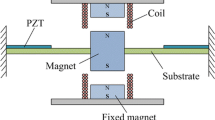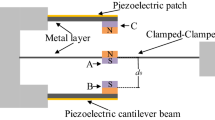Abstract
Due to the large vibration of fully mechanized mining equipment, using multi-field coupled piezoelectric energy harvester will efficiently solve the difficulty of wireless monitoring power supply by capture vibration energy. The study of dynamic characteristics of the MPEH under random excitation can effectively guide the design and optimization of the piezoelectric energy harvester. We make investigation of the distance effect of magnet, noise spectrum density and damping on the dynamic response characteristics of the MPEH under longitudinal and horizontal excitation. The results show that narrowing magnetic distance under longitudinal excitation, reducing damping ratio or increasing excitation spectral density can enhance the probability of large period vibration and increase the average power of the system.
Access provided by Autonomous University of Puebla. Download conference paper PDF
Similar content being viewed by others
Keywords
1 Introduction
In recent years, the wireless sensor technology and intelligent monitoring technology has provided a new and effective way to replace the traditional wired underground environmental monitoring means in coal mines [1]. However, complex environment of coalmine means the difficulties of power supply of wired monitoring. The mechanical vibration produced in the working process of fully mechanized mining equipment in the coal mine is the most common kind of mechanical energy. Therefore, the construction of efficient vibration energy collection system is called upon to realize the self-power supply of wireless network nodes in coal mine [2, 3].
The piezoelectric vibration energy harvesting, owing to its superiority in structure and application, has been receiving more attention [4, 5]. The structural design of multi-field coupled piezoelectric energy harvester (MPEH) can effectively solve the problems of narrow resonance band of traditional linear piezoelectric harvester. Mechanical vibration is normally expressed as a broad-band random signal. Therefore, design and verification of MPEH should be studied not only under harmonic excitation, but also under random excitation.
2 Design and Modeling
The design of MPEH included four linear-arch beams, four flexible piezoelectric material polyvinylidene fluoride (PVDF), two permanent magnets and a mass block with permanent magnets in MPEH. The structure is illustrated in Fig. 1. Four PVDFs adhere to four metal beams, respectively. Four beams are connected to the same mass block, which has two permanent magnets on it. The distance between two adjustable magnets is changed by adjusting the screw thread of the casing.
Generalized Hamilton principle and piezoelectric theory are used [6] to obtain the model:
where \(r\left( t \right)\) and \(v\left( t \right)\) are the displacement mode function and voltage mode function, respectively. \(\ddot{z}\left( t \right)\) denotes the acceleration of the base excitation. And, it will be instead as Gaussian white noise \(W\left( \tau \right)\), which the spectral density is \(K_{n}\), when excitation is random.
The axial and radial vibration signals of rocker arm in no-load operation of coal mining machine are measured and analyzed, respectively. It is noted that the highest frequency range is between 15 and 25 Hz. Therefore, determining the structure size of the system to meet the requirements of excitation frequency is one of the important aspects of MPEH optimization design. The regularity of the influence of structural size is illustrated in Fig. 2.
3 Dynamic Response
In order to study the effect of magnet distance, noise spectral density and system damping on the response of the MPEH, the system response under random excitation is solved by the FPK equation method. The response results under longitudinal and horizontal excitation conditions are tested. In the following figures, the left are the longitudinal excitation condition, and the right are horizontal excitation (Figs. 3, 4, 5 and 6).
4 Conclusion
In order to adapt to the working frequency of coal mine machinery, structural optimization design of MPEH and the test under excitation conditions are carried out. Under longitudinal excitation, add magnetic attraction and the magnetic distance is reduced, the variance of vibration probability distribution of the system increases and the probability of large period vibration increases. However, the influence of the magnetic distance is the opposite under horizontal excitation. Reducing damping ratio or increasing noise spectral densities will increase the system output.
References
He Q, Dong C, Li K, Wang J, Xu D, Li X (2018) A multiple energy-harvester combination for pattern-recognizable power-free wireless sensing to vibration event. Sens Actuators A Phys 279:229–239
Sudevalayam S, Kulkarni P (2011) Energy harvesting sensor nodes: survey and implications. IEEE Commun Surv Tutorials 13(3):443–461
Yang Z, Zhou S, Zu J, Inman D (2018) High-performance piezoelectric energy harvesters and their applications. Joule 2(4):642–697
Zhou S, Wang J (2018) Dual serial vortex-induced energy harvesting system for enhanced energy harvesting. AIP Adv 8(7):075221
Zhang X, Yang W, Zuo M, Tan H et al (2018) Arc-shaped piezoelectric bistable vibration energy harvester: modeling and experiments. Sensors 18(12):4472
Erturk A, Inman DJ (2009) An experimentally validated bimorph cantilever model for piezoelectric energy harvesting from base excitations. Smart Mater Struct 18(2):025009
Author information
Authors and Affiliations
Corresponding authors
Editor information
Editors and Affiliations
Rights and permissions
Copyright information
© 2021 Springer Nature Singapore Pte Ltd.
About this paper
Cite this paper
Zhang, X., Zuo, M., Wang, L., She, X. (2021). The Response Analysis of Multi-Field Coupled Piezoelectric Energy Harvester Under White Gaussian Noise Excitation. In: Xu, L., Zhou, L. (eds) Proceedings of the 8th International Multidisciplinary Conference on Optofluidics (IMCO 2018). IMCO 2018. Lecture Notes in Electrical Engineering, vol 531. Springer, Singapore. https://doi.org/10.1007/978-981-13-3381-1_19
Download citation
DOI: https://doi.org/10.1007/978-981-13-3381-1_19
Published:
Publisher Name: Springer, Singapore
Print ISBN: 978-981-13-3380-4
Online ISBN: 978-981-13-3381-1
eBook Packages: EngineeringEngineering (R0)










